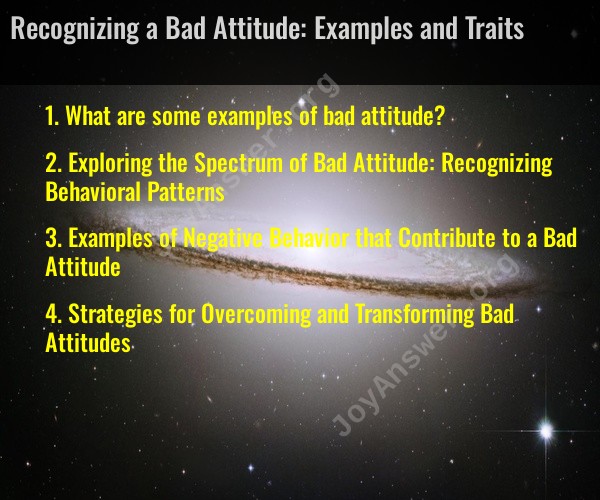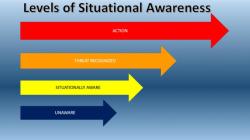What are some examples of bad attitude?
A bad attitude can manifest in various ways, and its examples can differ across different contexts. Here are some common traits and examples of a bad attitude:
Negativity: Constantly focusing on the negative aspects of situations, people, or events.
- Example: Always complaining about everything without acknowledging the positive aspects.
Pessimism: Expecting the worst outcomes and expressing a lack of hope or optimism.
- Example: Believing that a project will fail before even starting and expressing doubts openly.
Arrogance: Displaying an exaggerated sense of self-importance and superiority.
- Example: Belittling others' opinions and considering oneself to be above everyone else.
Lack of Accountability: Refusing to take responsibility for one's actions or mistakes.
- Example: Blaming others for personal failures instead of acknowledging one's role.
Disrespect: Treating others with rudeness, contempt, or disregard for their feelings.
- Example: Interrupting someone repeatedly during a conversation or dismissing their ideas.
Stubbornness: Unwillingness to adapt or consider alternative viewpoints.
- Example: Rejecting suggestions without considering their potential benefits.
Unreliability: Consistently failing to follow through on commitments or promises.
- Example: Not completing assigned tasks on time or consistently breaking promises.
Lack of Empathy: Being indifferent to others' emotions or needs.
- Example: Ignoring a friend's struggles or showing no concern for their well-being.
Impatience: Displaying irritability and intolerance towards delays or challenges.
- Example: Becoming frustrated and angry when things don't go as planned.
Gossiping: Engaging in negative discussions about others behind their backs.
- Example: Spreading rumors or making derogatory comments about colleagues or friends.
Recognizing these traits can help individuals identify and address a bad attitude, fostering better relationships and a more positive environment.
Exploring the Spectrum of Bad Attitude
A bad attitude, often a dark cloud looming over interactions, can manifest in various ways. It's essential to recognize the behavioral patterns it entails and address them effectively. Let's delve into its depths:
1. Recognizing Behavioral Patterns:
- Negativity: A constant stream of pessimism, cynicism, and complaints casts a shadow on everything. Imagine a raincloud perpetually following someone around. (Image of a dark raincloud following a person)
- Defensiveness: An automatic reaction of hostility and justification in response to any perceived criticism or feedback, building walls instead of bridges. (Image of a person building a brick wall around themselves)
- Passivity and disengagement: A lack of enthusiasm, initiative, and effort, often coupled with apathy and withdrawal. Think of a deflated balloon, lacking the spark to fly. (Image of a deflated balloon)
- Aggression and hostility: Open displays of anger, blame, and even physical aggression, pushing others away with barbed words and actions. Picture a prickly cactus repelling any touch. (Image of a prickly cactus)
- Manipulation and guilt tripping: Using emotional tactics to control situations and others, fostering unhealthy dynamics and resentment. Imagine a puppet master pulling strings behind the scenes. (Image of a puppet master controlling puppets)
2. Examples of Negative Behavior:
- Constant complaining and grumbling
- Sarcasm and snide remarks
- Dismissive or disrespectful attitude
- Refusal to take responsibility for actions
- Blaming others for problems
- Sulking and withdrawal
- Outbursts of anger or aggression
- Passive-aggressive behavior
Strategies for Overcoming and Transforming Bad Attitudes:
- Self-awareness: Recognizing your own triggers and patterns is the first step towards change. Mindfulness practices like meditation can help. (Image of a person meditating)
- Challenge negative thoughts: Replace cynicism with hope, blaming with accountability, and negativity with gratitude. Cognitive reframing techniques can be helpful. (Image of a person replacing a negative thought bubble with a positive one)
- Focus on solutions: Instead of dwelling on problems, actively seek solutions and take constructive action. (Image of a person brainstorming solutions on a whiteboard)
- Practice positive communication: Use "I" statements, active listening, and empathy to build bridges instead of walls. (Image of two people communicating with speech bubbles containing "I" statements)
- Seek support: Talking to a therapist or counselor can provide valuable tools and strategies for managing negative emotions and behaviors. (Image of a person talking to a therapist)
Remember, transforming a bad attitude is a journey, not a destination. Be patient with yourself, celebrate small victories, and keep moving towards a more positive outlook. With dedication and effort, you can cultivate a sunnier disposition and illuminate your own path and those around you.
I hope this information helps you navigate the spectrum of bad attitude and find pathways to positive transformation!












